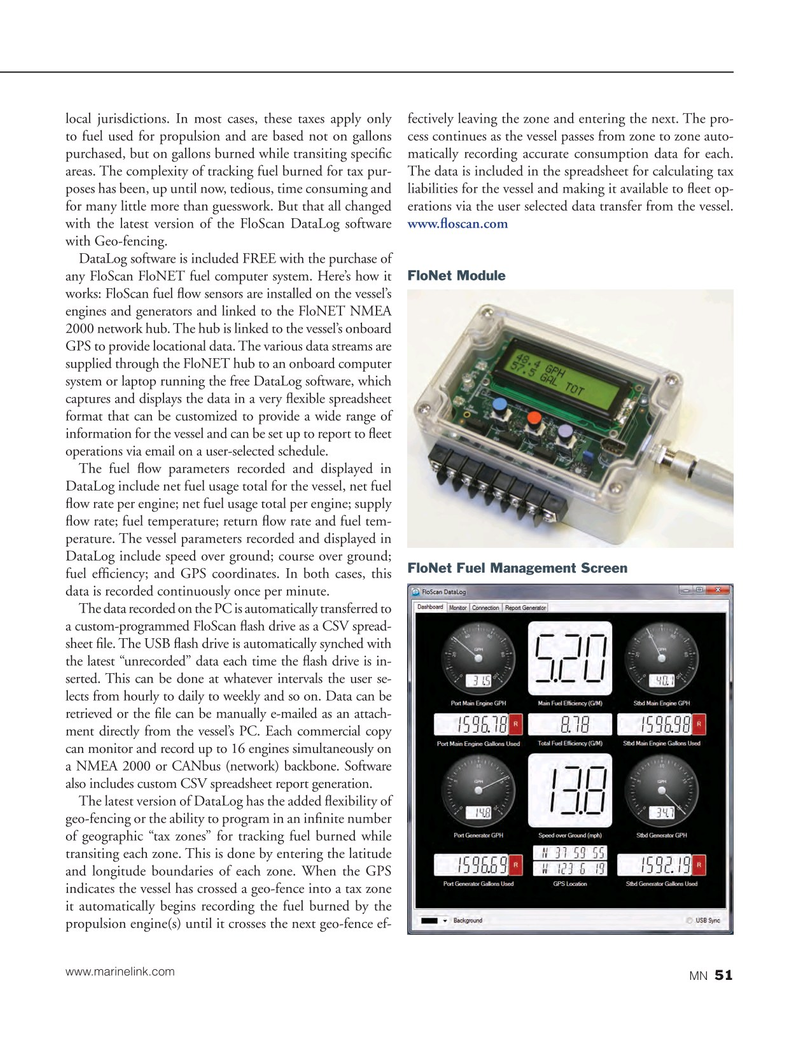
Page 51: of Marine News Magazine (June 2015)
Combat & Patrol Craft Annual
Read this page in Pdf, Flash or Html5 edition of June 2015 Marine News Magazine
local jurisdictions. In most cases, these taxes apply only fectively leaving the zone and entering the next. The pro- to fuel used for propulsion and are based not on gallons cess continues as the vessel passes from zone to zone auto- purchased, but on gallons burned while transiting speci? c matically recording accurate consumption data for each. areas. The complexity of tracking fuel burned for tax pur- The data is included in the spreadsheet for calculating tax poses has been, up until now, tedious, time consuming and liabilities for the vessel and making it available to ? eet op- for many little more than guesswork. But that all changed erations via the user selected data transfer from the vessel. with the latest version of the FloScan DataLog software www.? oscan.com with Geo-fencing.
DataLog software is included FREE with the purchase of
FloNet Module any FloScan FloNET fuel computer system. Here’s how it works: FloScan fuel ? ow sensors are installed on the vessel’s engines and generators and linked to the FloNET NMEA 2000 network hub. The hub is linked to the vessel’s onboard
GPS to provide locational data. The various data streams are supplied through the FloNET hub to an onboard computer system or laptop running the free DataLog software, which captures and displays the data in a very ? exible spreadsheet format that can be customized to provide a wide range of information for the vessel and can be set up to report to ? eet operations via email on a user-selected schedule.
The fuel ? ow parameters recorded and displayed in
DataLog include net fuel usage total for the vessel, net fuel ? ow rate per engine; net fuel usage total per engine; supply ? ow rate; fuel temperature; return ? ow rate and fuel tem- perature. The vessel parameters recorded and displayed in
DataLog include speed over ground; course over ground;
FloNet Fuel Management Screen fuel ef? ciency; and GPS coordinates. In both cases, this data is recorded continuously once per minute.
The data recorded on the PC is automatically transferred to a custom-programmed FloScan ? ash drive as a CSV spread- sheet ? le. The USB ? ash drive is automatically synched with the latest “unrecorded” data each time the ? ash drive is in- serted. This can be done at whatever intervals the user se- lects from hourly to daily to weekly and so on. Data can be retrieved or the ? le can be manually e-mailed as an attach- ment directly from the vessel’s PC. Each commercial copy can monitor and record up to 16 engines simultaneously on a NMEA 2000 or CANbus (network) backbone. Software also includes custom CSV spreadsheet report generation.
The latest version of DataLog has the added ? exibility of geo-fencing or the ability to program in an in? nite number of geographic “tax zones” for tracking fuel burned while transiting each zone. This is done by entering the latitude and longitude boundaries of each zone. When the GPS indicates the vessel has crossed a geo-fence into a tax zone it automatically begins recording the fuel burned by the propulsion engine(s) until it crosses the next geo-fence ef- www.marinelink.com
MN 51

 50
50

 52
52
